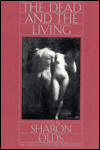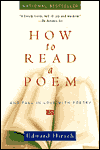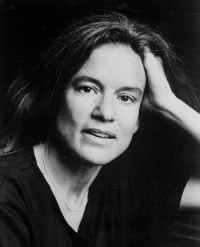NYS WRITERS INSTITUTE
HOME PAGE

|
 Edward Hirsch Edward Hirsch Winner of MacArthur "Genius" Grant |
NYS Writers Institute, November 30, 2004
4:15 p.m. Seminar | Assembly Hall, Campus Center, Uptown Campus
8:00 p.m. Reading | Recital Hall, Performing Arts Center, Uptown Campus
| "When I was invited to teach at a hospital for the severely disabled . . . some of the people in the class are nonmoving and nonspeaking . . . I said yes. . .(18:12) |
 PROFILE
PROFILE
A former New York State Poet, Sharon Olds received the National Book Critics Circle Award and the Lamont Poetry Prize of the Academy of American Poets for "The Dead and the Living" (1984), which sold more than 50,000 copies. She was also a National Book Award finalist for both "The Father" (1992) and "The Unswept Room" (2002). In 2002, Olds received an Academy Fellowship from the Academy of American Poets for "distinguished poetic achievement at mid-career."
 A winner of a MacArthur "Genius" grant, poet Edward Hirsch is the author of the national bestseller, "How to Read a Poem and Fall in Love with Poetry" (1999). For his 1986 collection, "Wild Gratitude," he received the National Book Critics Circle Award. Hirsch also serves currently as President of the Guggenheim Foundation, one of the world's most influential arts-oriented foundations, and writes the "Poet's Choice" column for the "Washington Post Book World."
A winner of a MacArthur "Genius" grant, poet Edward Hirsch is the author of the national bestseller, "How to Read a Poem and Fall in Love with Poetry" (1999). For his 1986 collection, "Wild Gratitude," he received the National Book Critics Circle Award. Hirsch also serves currently as President of the Guggenheim Foundation, one of the world's most influential arts-oriented foundations, and writes the "Poet's Choice" column for the "Washington Post Book World."
Sharon Olds is acclaimed for her use of raw, plain-spoken language and startling images to convey truths about domestic and political violence, sexuality, family relationships, and the body. Writing in the "New York Times," Dinitia Smith said, "Her work has a robust sensuality that is almost Whitmanesque. She has made the minutiae of a woman's everyday life as valid a subject for poetry as the grand abstract themes that have preoccupied other poets."
Olds was 37 when she published her first book of poems, "Satan Says." Her recent collections include "Blood, Tin, Straw" (1999), "The Unswept Room" (2002), and her newest book "Strike Sparks: Selected Poems 1980-2002" (2004). "Strike Sparks" is a collection of 117 of Olds's finest poems drawn from her seven previously published volumes. The "Kansas City Star" praised the collection as "Bold. Unsettling. Obsessive. . . . Breakthrough subjects and burning observations . . . show Olds pushing at the boundaries of contemporary American poetry." The "San Francisco Chronicle" noted that Olds's popularity stems from "saying that which is difficult to say," and praised her ability to turn "images and phrases with coy and tender precision."
In six highly-praised collections of poetry, Hirsch is known for poems that respond to great works of art in various disciplines, as well as his willingness to impersonate the voices of great poets, writers and thinkers of the past, from Charles Baudelaire to Emily Dickinson to Jimi Hendrix. His collections include "On Love" (1998), "Earthly Measures" (1994), "The Night Parade" (1989), "Wild Gratitude" (1986), and "For the Sleepwalkers" (1981).
Hirsch's most recent poetry collection is "Lay Back the Darkness" (2003), a meditation on life and death at middle age. In a starred "Booklist" review, Donna Seaman wrote, "Whether he's contemplating Homer or the Holocaust, standing transfixed before a painting by Agnes Martin, or holding a handful of fresh figs, Hirsch embraces language as a mystical force, and he and his readers truly are transported."
Renowned as both poet and teacher, Edward Hirsch served as Professor of English at the University of Houston for seventeen years. His teaching talents are evident in his 1999 bestseller "How to Read a Poem and Fall in Love with Poetry," a book that overflows with brilliant examples of the art, as well as witty epigrams, apt metaphors, ingenious turns-of-phrase, and countless tips and words of advice about getting the most out of poetry-an ecstatic form of communication in the author's view. Hirsch's follow-up to "How to Read a Poem" is "The Demon and the Angel: Searching for the Source of Artistic Inspiration" (2002), a wide-ranging and readable examination of the mysteries of creativity. Artists examined in the book include William Blake, Louis Armstrong, T. S. Eliot, Sylvia Plath, Robert Motherwell, Federico Garcia Lorca, among many others.
For additional information, contact the Writers Institute at 518-442-5620 or online at https://www.albany.edu/writers-inst.
 Sharon Olds
Sharon Olds